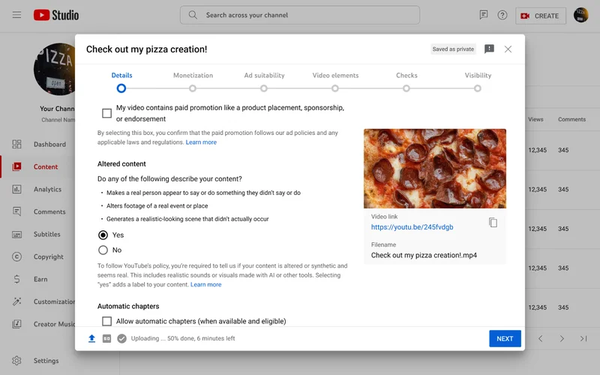by Colin Kirkland
Source: www.mediapost.com, March 2024
After making an initial announcement in November, YouTube is officially rolling out a new set of rules around synthetic media.
To enforce a sense of transparency around what users are seeing on the video-sharing app, YouTube is now requiring creators to publicly disclose when they upload synthetic content, including generative AI, that they have altered or created to be realistic in any way.
The synthetic media disclosure will appear in the form of a label in a video’s expanded description or on the front of the video player, YouTube says, adding that the label is designated for content that may allude users in relation to its realness, not content that is “clearly unrealistic, animated, includes special effects, or has used generative AI for production assistance.”
In addition, YouTube will not require creators to disclose whether generative AI was used for “productivity,” like the creation of scripts, content ideas or automatic captions.
Content that requires a label either uses the likeness of a realistic person (otherwise known as a deepfake), includes altered footage of real events or places, and/or generates realistic scenes, “like a tornado moving toward a real town.”
According to the company, the new label was designed to “strengthen transparency with viewers and build trust between creators and their audience.”
It is no surprise that the new rules are rolling out in advance of the upcoming US presidential election, which experts believe will be affected by the proliferation of artificial intelligence and deepfakes used to spread dangerous disinformation related to candidates, political movements, statistics and current events.
“Voters can be steered toward or away from candidates — or even to avoid the polls altogether,”; notes a recent report by the Associated Press. “But perhaps the greatest threat to democracy, experts say, is a surge of AI deepfakes could erode the public’s trust in what they see and hear.”
In the future, Youtube says it will devise enforcement measures for creators who consistently choose not to disclose information surrounding synthetic content, such as adding the missing label automatically.
All synthetic content labels will begin to roll out across all platform surfaces and formats in the weeks ahead, beginning with the YouTube app on people’s phones, followed by desktop and TV.

